Note: This publication is currently undergoing major revisions. The current publication will be replaced with a new publication based on stakeholder requirements and scientific advances. We expect to begin sharing details on this soon. If you have input on content, format, or publication frequency at any time, please contact us at cbrfc.webmasters@noaa.gov.Lower Colorado Water Supply Outlook, March 1, 2011Lower Colorado Water Supply Outlook, March 1, 2011
Contents
Lower Colorado Summary
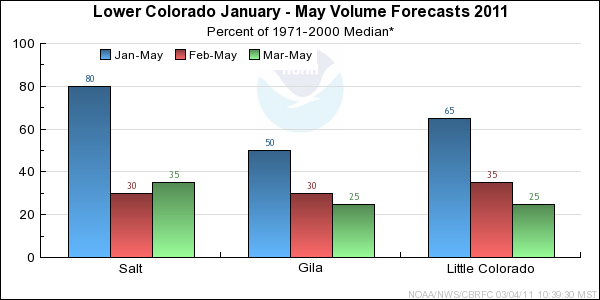
*Median of forecasts within each basin.
Salt Basin Conditions
The following conditions influenced this month's forecasts:
Precipitation:
Seasonal October-February
precipitation was
near 80 percent of average in the upper Salt River Basin and 90 to 130 percent of average in the Verde River Basin.
February
precipitation was 75 percent of average in the upper Salt Basin and near average in the
Verde Basin.
Streamflow:
February streamflow was near 30 percent of median on the Salt River, 45 percent of median on the Tonto, and 75% of median
on the Verde River.
Snow:
March 1st snowpack varied from 50 to 165 percent of average in the Verde River Basin, with the majority of
sites reporting below average conditions. Snowpack in the upper Salt River Basin was generally less than
65 percent of average. In all areas snowpack was limited in areal coverage.
Salt River Basin
Snow Plot.
Verde River Basin
Snow Plot.
Soil Moisture:
Below average precipitation during the late summer and fall resulted in below average
modeled soil moisture states in the upper Salt River Basin. Wetter soil moisture
conditions exist in the Verde Basin as more frequent precipitation events
have occurred this winter.
Climate Forecasts:
La Nina climate conditions suggest decreased chances for precipitation in this area.
The La Nina influence was accounted for in generation of these forecasts.
Forecast Summary:
February storms affected primarily the upper Verde and western Arizona with near to
above average precipitation for the month. The Salt River Basin experienced below
average precipitation and entered the runoff season with drier soil moisture
conditions compared to the Verde Basin. While a few sites reported above average
snowpack conditions, most areas have recorded much below average snowpack. Streamflow in
February was also well below median.
These conditions are somewhat consistent with La Nina climate conditions that currently
exist. Below average precipitation and below median runoff are observed more
frequently during La Nina events. March-May
forecast volumes are for 20 percent of median in the
Salt River Basin, near 35 percent of median in the Tonto Basin, and near 40 percent of
median in the Verde Basin.
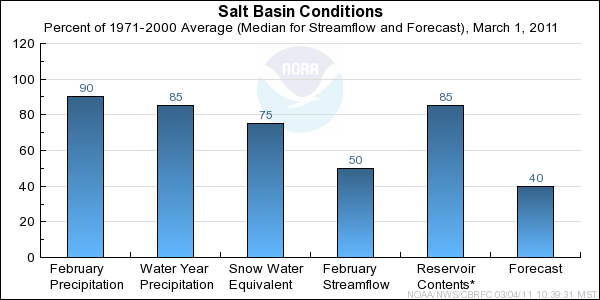
* Percent usable capacity, not percent average contents.
Click for multi-month Graph.
Gila Basin Conditions
The following conditions influenced this month's forecasts:
Precipitation:
Seasonal October-February
precipitation was
ranged from near 30 to 50 percent of average.
February
precipitation was ranged from near 30 to 45 percent of average.
Streamflow:
February streamflow was near 35 percent of median.
Snow:
March 1st snowpack conditions were near 50 percent of average in San Francisco Basin and
20 to 40 percent of average in the upper Gila Basin.
Upper Gila Basin
Snow Plot.
San Francisco Basin
Snow Plot
Soil Moisture:
Below average precipitation has resulted in below average modeled soil moisture
states.
Climate Forecasts:
La Nina climate conditions suggest decreased chances for precipitation in this area.
The La Nina influence was accounted for in generation of these forecasts.
Forecast Summary:
Several conditions exist that support much below median March-May streamflow
volumes in the Gila River Basin. These include below average seasonal precipitation and soil
moisture, and much below average snowpack. The presence of La Nina climate
conditions suggest drier than average conditions have a better chance of occuring through
the forecast period. March-May
forecast volumes range from 15 to 30
percent of median.

* Percent usable capacity, not percent average contents.
Click for multi-month Graph.
Little Colorado Basin Conditions
The following conditions influenced this month's forecasts:
Precipitation:
Seasonal October-February
precipitation ranged from near
60 percent of average in the headwater locations up to 125 percent of average near the
basin outlet.
February
precipitation ranged from 65 to 105 percent of average throughout most of the Little Colorado Basin.
Streamflow:
February streamflow on the Little Colorado at Lyman was near 45 percent of median.
Snow:
Basin snowpack conditions on February 1st were near 70 percent of average in the southern Headwaters.
Little Colorado Southern Headwaters
Snow Plot
Central Mogollon Rim
Snow Plot
Soil Moisture:
Modeled soil moisture states varied throughout the Little Colorado. Below average
seasonal precipitation resulted in below average soil moisture conditions in the headwater locations.
Elsewhere soil moisture conditions were similar or wetter than last year entering the runoff
period.
Climate Forecasts:
La Nina climate conditions suggest decreased chances for precipitation in this area.
The La Nina influence was accounted for in generation of these forecasts.
Forecast Summary:
The presence of La Nina climate conditions suggest below average precipitation into the
spring. Below average seasonal precipitation exists over most of the Little Colorado Basin,
with below average soil moisture conditions in the headwaters. Snowpack conditions changed
little from February 1st to March 1st, and remain below average.
March-May streamflow volumes are
forecast to range from near 15 to 40 percent of median.
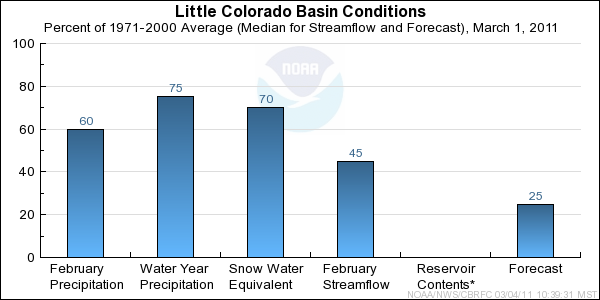
* Percent usable capacity, not percent average contents.
Click for multi-month Graph.
Differences between the full period forecasts and the residual forecasts may not exactly equal the actual observed volumes due to rounding conventions (see Definitions section).
Monthly Streamflows

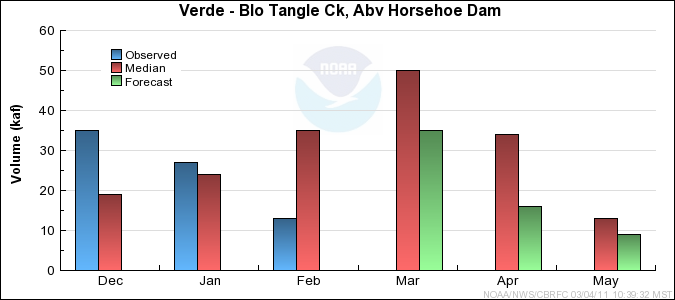

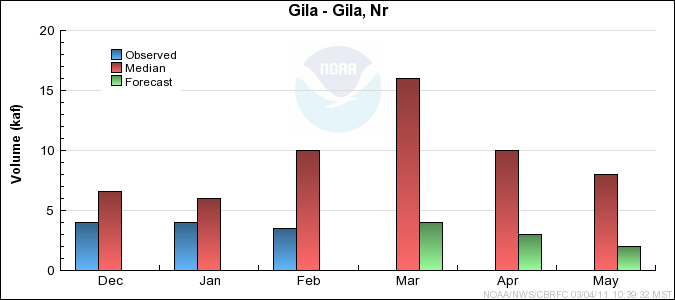
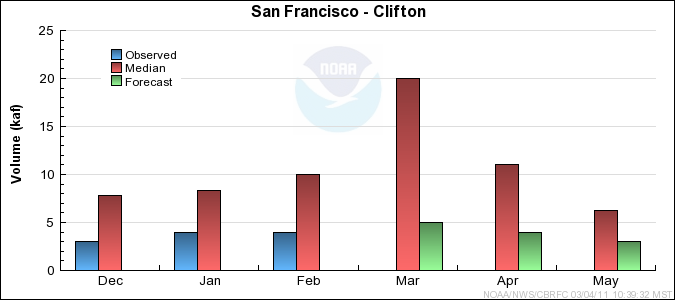
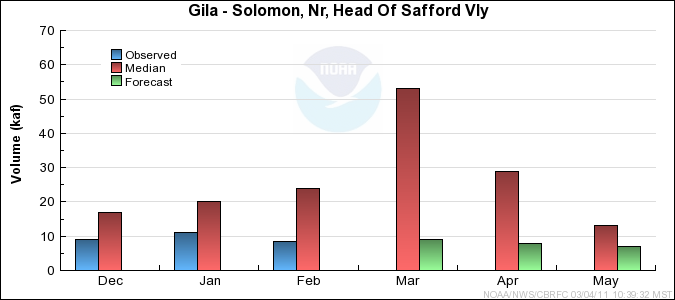
Precipitation Maps
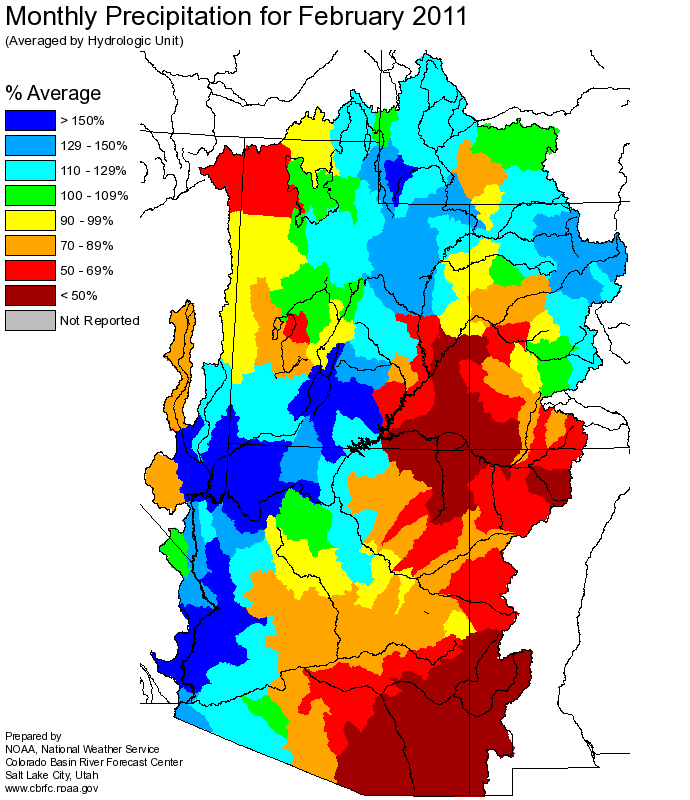
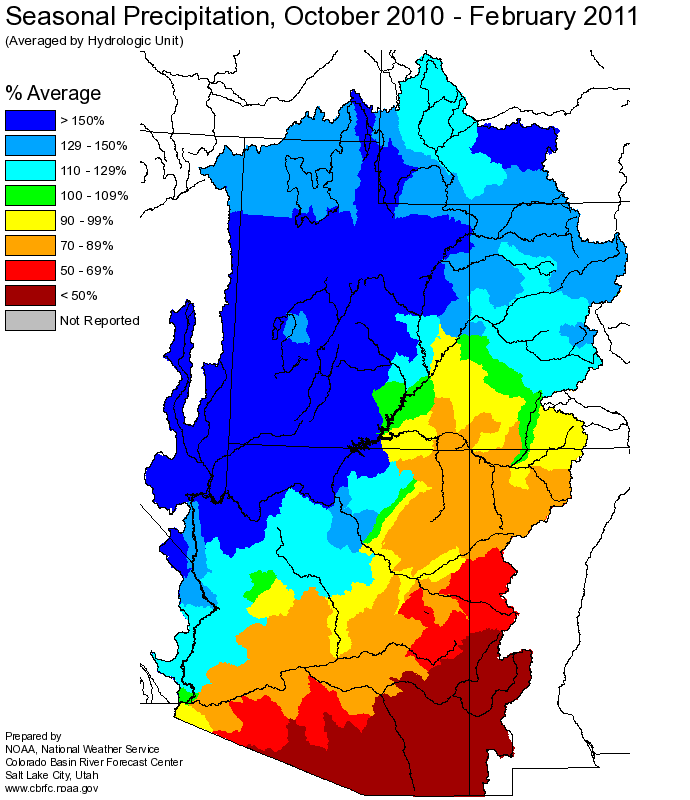
Hydrologist: G. Smith













